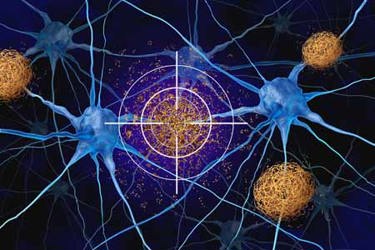Periodontitis And Neurological Disease: New Insights For Drug Targeting
By Jay Lombard, DO; Kiran Dintyala, MD, MPH, ABIHM; and Niranjan Kumar, Ph.D., PDF, EMTM

More than 140 million Americans, nearly half of the U.S. population, suffer from periodontitis, which raises critical health concerns as it has been associated with an increased risk of cancer, heart disease, and neurological disorders including Alzheimer’s dementia. Periodontitis is regarded as an inflammatory disorder involving a chronic infectious etiology. While over several hundred different infectious species have been linked to periodontal disease, Porphyromonas gingivalis, a Gram-negative, anaerobic bacterial species, predominates. Several virulence factors that are shared between numerous bacterial and fungal species are demonstrated to play a role in the subgingival space, including the secretion of adhesins that precipitate in the development of biofilm, lipopolysaccharides that promote bone resorption, cellular iron competition between host and pathogen, and proteases, the enzymes that cause tissue destruction. This up-to-date review will discuss the evidence regarding the pathological link between periodontal disease and systemic disorders, focusing most critically on the association between proteases including gingipain — a bacterial protease — and neurological dysfunction. Preventive and therapeutic measures that target these pathological pathways in the diseased periodontal pocket can improve and reduce tissue and bone breakdown.
Periodontal disease is characterized by the destruction of alveolar bone and periodontal ligaments. Studies show that oral disease is connected to serious health conditions like heart disease and Alzheimer’s. It affects 45%–50% of the world’s population, with the most severe form in 11.2% of the world's population, making it the sixth most common human disease.1 Independent associations between severe periodontitis and cardiovascular disease have been found and seem to involve endothelial dysfunction and impaired vascular relaxation. In longitudinal studies assessing incident cardiovascular events, periodontitis was found to be an independent risk factor for cardiovascular disease and is significantly associated with all‐cause and cardiovascular mortality in several different populations.2 A recent study found that 100% of patients with cardiovascular disease had P. gingivalis arterial colonization through oral microbe identification applying next-generation sequencing.3 Periodontal disease may contribute to the pathogenesis of Alzheimer's disease, where Gram-negative bacteria can penetrate the blood brain barrier due to the proximity of the oral cavity to the para-meningeal sinuses where adhesion molecules can facilitate translocation. Secretion of bacterial proteases from Gram-negative bacteria can induce the production and aggregation of Aβ, which may affect the onset and progression of AD.3 In addition to increasing the risk of cardiovascular disease and cognitive dysfunction, the prevalence of anxiety and depression has been speculated to be etiologically associated with periodontal disease. For example, a meta-analysis showed that data from case-control studies show a positive association between depression and periodontitis.4
Current And Future Approaches To Periodontal Disease
Currently, specific treatment of severe periodontitis consists only of curettage of the affected area and the adjunct doxycycline (Periostat), which is approved by the FDA. Advances in the molecular biology of periodontal disease offer the opportunity to reduce the burden of periodontal pathogens by neutralizing their virulence properties. These include the potential inhibition of oral biofilm, which is a complex mixture of bacterial components and other species, including fungal pathogens. The oral cavity contains an estimated 1.5 × 1012 oral bacteria that lead to the formation of “pockets,” typically harboring hundreds of different species that accumulate in the formation of biofilm. The periodontal pocket presents an anoxic environment where the detection rate of Porphyromonas gingivalis, one of the major pathogens of periodontitis in subgingival biofilm, is as high as 60.9%.5 Immunological responses against periodontal pathogens can be determined by measuring the serum immunoglobulin G (IgG) antibody level against periodontal pathogens using enzyme-linked immunosorbent assays (ELISA). Recombinant antigens secreted by Porphyromonas gingivalis include strong cysteine proteases such as Lys-gingipain and Arg-gingipain, which account for as much as 85% of extracellular proteolytic ability.6 Porphyromonas gingivalis can cause cognitive decline where gingipains are found in association with neurons and beta‐amyloid in specimens from the brains of individuals with Alzheimer’s disease.
The Molecular Mechanisms Of Biofilm Production
The formation of biofilm involves the exploitation of host iron metabolism, where pathogenic bacteria in the oral cavity compete with tightly regulated iron that is critical in promoting the growth and virulence of Gram-negative bacteria.7 Porphyromonas gingivalis is unable to synthesize heme, an important source for iron, where during its acquisition can lead to highly oxidative species in the presence of free radicals and lipopolysaccharides (LPS). The LPS are important pro-inflammatory molecules involved in the pathogenesis of periodontal disease where Arg-gingipains are immunologically related to the production of LPS.8
The production of heme oxygenase and the elevation of matrix metalloproteinases (MMPs) are linked to periodontal disease pathogenesis. Immunohistochemical staining of gingival tissue samples taken from patients with periodontal disease showed increased expression of heme oxygenase -1 in the gingival tissue samples, suggesting it may play an endogenous protective role to degrade the oxidation of free heme.9 Evidence has shown that elevated salivary levels of matrix metalloproteinases enzymes are associated with periodontal tissue damage. Proteolytic cascades can lead to extensive destruction of the periodontal tissue due to the activation of MMPs during the active stages of periodontitis.10
Periodontitis And Neurological Dysfunction
Porphyromonas gingivalis, a Gram-negative anaerobic bacterium associated with the initiation and progression of adult periodontal disease is also associated with brain dysfunction. Unlike other Gram-negative bacteria, the acquisition of heme/hemoglobin is critical for its virulence. P. gingivalis secretes proteases that acquire iron/heme from host tissue through the transcription of a family of protease/hemagglutinins termed gingipains. Gingipain expression is central in the development of P. gingivalis virulence during infection of the oral cavity.11
Gingipains are cysteine proteases that exhibit a large hemagglutinin/adhesion domain that play a key role in the pathogenesis of periodontal disease.12 Gingipains (a type of protease secreted by bacteria) help the bacteria colonize tissue in the sub-gingival regions (areas under the gum line). This colonization creates a “niche” or a suitable habitat for the bacteria. Additionally, gingipains degrade host proteins, which means they break down proteins in the host’s body to provide essential nutrients for their own growth. Therefore, the “niche” here is the specific area in the host’s body where the bacteria can thrive. Gingipains play an indispensable role in the release of hemin from hemoglobin, as they use hemoglobin as a source of iron more effectively than other iron sources.13
The most significant consequence of gingipains’ role in bacterial utilization of heme is the production of oxidative stress, as free iron is capable of catalyzing the conversion of hydrogen peroxides to free radicals, referred to as the Fenton reaction. 8-oxoG, the major product of DNA oxidation, is highly elevated in the saliva of patients with periodontal disease compared to healthy subjects. Elevated oxo-guanosine is also an indirect marker of ferroptosis and has been reported in samples from patients with periodontitis. Hemagglutinins participate in adherence interactions with host cells, while proteinases contribute to inactivation of the effector molecules of the immune response and to tissue destruction.
Gingipains have been detected in the brain of Alzheimer’s patients and have been proposed as a contributory factor to the development of dementia with chronic periodontitis.14,15,16 These studies clearly establish the relationship between periodontitis and brain health. Recent reports suggest that gingipains are the major proteases involved in hemin acquisition, binding and accumulating in P. gingivalis.17 In vivo brain colonization by Porphyromonas gingivalis has been detected in autopsy specimens from the brains of people with AD and in cerebrospinal fluid of individuals diagnosed with Alzheimer’s disease. Gingipain secreted by P. gingivalis can affect the activation of γ-secretase, which is known to be associated with Aβ production. In particular, gingipains activate metalloproteinases that can induce massive generation of Aβ.18 Furthermore, gingipain levels are increased in the AD brain compared to the healthy brain and reported to co-localize with Aβ.15
Bacterial Agents and The Blood–Brain Barrier
Gram-negative bacteria internalize into the BBB through transcytosis via interactions between bacterial proteases and endothelial cells to produce biofilm.19 Bacterial biofilm exhibits an amyloid-like biophysical nature similar to human-derived amyloids, including the aggregate-forming ability.20 In the production of biofilm, quorum sensing (QS) helps periodontal bacteria communicate, mostly limited to periodontal pathogens, including P. gingivalis isolated from patients with dental biofilm-associated diseases.21
The production of bacterial biofilm helps mask immunogenic bacterial agents that prevent the triggering of the host immune responses. Although the amyloid produced by bacteria differs in its primary structure from the amyloid produced in the CNS, they have similarities in their tertiary structure. Amyloid refers to aggregated insoluble lipoproteins that exhibit β-pleated conformations.22 Hemagglutinin expressed by P. gingivalis are complexed with LPS and lipid cell surfaces that are found on the outer membrane of Gram-negative bacteria involved in the inflammatory and pathological processes associated with amyloidosis characteristic of AD. Release of LPS stimulation increases the expression of adhesion molecules in BBB endothelial cells, which potentially increases immune cell entry into the BBB. LPS-induced systemic inflammation could provoke Aβ clearance impairment via (1) down-regulated expression of low-density lipoprotein receptor-related protein 1 (LRP-1) and (2) inhibition of Aβ entry into the blood vessels in the brain. These studies demonstrate that the LPS-induced Aβ burden and Aβ plaques could play key roles in Aβ-related AD pathology as LPS facilitates neurodegeneration.
In addition to the bacterial production of LPS and hemagglutinin, iron is significantly elevated in multiple regions of the brain in AD, where neurodegeneration has been proposed to induce oxidative stress and ferroptosis.23 Evidence of iron dysregulation in AD includes biomarkers for high brain iron levels. CSF ferritin levels have been shown to predict cognitive decline across the clinical severity spectrum of AD.24 Free iron is highly reactive and can trigger the Fenton reaction and catalyze the production of large amounts of reactive oxygen species. Periodontal tissue is associated with upregulation of ferritin, and heme acquisition by Polymorphus gingivalis has been postulated to be one of the primary factors involved in periodontal disease pathogenesis.25
Free iron ultimately inducing cellular ferroptosis and periodontal tissue destruction are disease mechanisms also associated with neurodegenerative, pathology, including AD, where heme oxygenase-1 (HO-1) provides neuroprotective effects by promoting healthy iron metabolism, exerting anti-inflammatory effects, and inhibiting glial activation of the brain against the toxicity of Aβ1–42.26
Therapeutic Implications
As there are strong relationships between periodontal disease and highly oxidized heme, these findings suggest that novel ways to chelate excess iron may play a dual role both in the prevention of periodontal disease and neurodegeneration related to oxidative stress. β-thujaplicin is a natural tropolone derivative that has a generally regarded as safe (GRAS) designation. β-thujaplicin was originally isolated from the heart wood of the conifer trees of the Cupressaceae family, which has been shown to potentially inhibit periodontal bone loss by inhibiting metalloproteinases’ induced collagen breakdown.27 β-thujaplicin possesses diverse biological and therapeutic properties, including its anti-inflammatory and antimicrobial effects, which may extend beyond the oral mucosa. As a natural monoterpenoid, it has highly significant activity against multiple oral pathogens, including Porphyromonas gingivalis.
The neuroprotective mechanisms of β-thujaplicin are based upon its ability to chelate pathological iron overload in cells by acting as natural action. In vitro studies have demonstrated that β-thujaplicin is also capable of transporting and safely removing multiple divalent metallic ions linked to Parkinson’s and Alzheimer’s disease. In the central nervous system, β-thujaplicin alleviated excessive glutamate and Fe2+ accumulation by upregulated heme oxygenase-1 (HO-1), with significant neuroprotective effects. In turn, the release of heme-oxygenase has multiple putative effects in periodontal disorders as an anti-inflammatory that degrades free iron, making it less available for oral pathogens and reducing the production of biofilm. In cell models, elevation of heme-oxygenase by β-thujaplicin inhibits the production of amyloid like plaque in the oral cavity, with a similar effect in cultured neuronal cells. These findings suggest that this novel monoterpenoid isolated from essential oil of the Cupressaceae family may help maintain oral and brain health by reducing bacterial mediated inflammation and restoring iron balance. On a clinical basis, monoterpenoids have local analgesic effects by inhibiting sodium channels involved in nociception. Thus, the properties of β-thujaplicin, including its unique ability to act as a natural metal chelator, with antimicrobial and anti-inflammatory effects in the oral mucosa, make it an ideal agent for the prevention of periodontal disease, with additional analgesic effects on a clinical basis. Due to its high safety record, a simple open label trial can be envisioned where new users can rate their satisfaction with their oral health, including reduced pain and inflammation in the gums. Brain Health has developed a proprietary oral formulation to promote antimicrobial and anti-inflammatory effects.
Acknowledgement
The authors would like to acknowledge Brain Health LLC. for its support.
References
- Kassebaum NJ, Bernabé E, Dahiya M, Bhandari B, Murray CJ, Marcenes W. Global burden of severe periodontitis in 1990-2010: A systematic review and meta-regression. J Dent Res. 2014;93(11):1045-53.
- Tonetti MS, Van Dyke TE; Working group 1 of the joint EFP/AAP workshop. Periodontitis and atherosclerotic cardiovascular disease: consensus report of the Joint EFP/AAP Workshop on Periodontitis and Systemic Diseases. J Clin Periodontol. 2013 Apr;40 Suppl
- Mougeot JC, Stevens CB, Paster BJ, Brennan MT, Lockhart PB, Mougeot FK. Porphyromonas gingivalis is the most abundant species detected in coronary and femoral arteries. J Oral Microbiol. 2017;9(1):1281562. doi:10.1080/20002297.2017.1281562
- Martínez M, Postolache TT, García-Bueno B, Leza JC, Figuero E, Lowry CA, Malan-Müller S. The Role of the Oral Microbiota Related to Periodontal Diseases in Anxiety, Mood and Trauma- and Stress-Related Disorders. Front Psychiatry. 2021;12:814177.
- Nagano K, Hasegawa Y, Iijima Y, Kikuchi T, Mitani A. Distribution of Porphyromonas gingivalis fimA and mfa1 fimbrial genotypes in subgingival plaques. PeerJ. 2018;6:e5581. doi:10.7717/peerj.5581.
- de Diego I, Veillard F, Sztukowska MN, Guevara T, Potempa B, Pomowski A, Huntington JA, Potempa J, Gomis-Rüth FX. Structure and mechanism of cysteine peptidase gingipain K (Kgp), a major virulence factor of Porphyromonas gingivalis in periodontitis. J Bio
- Caza M, Kronstad JW. Shared and distinct mechanisms of iron acquisition by bacterial and fungal pathogens of humans. Front Cell Infect Microbiol. 2013;3:80. doi:10.3389/fcimb.2013.00080)
- Paramonov N, Bailey D, Rangarajan M, Hashim A, Kelly G, Curtis MA, Hounsell EF. Structural analysis of the polysaccharide from the lipopolysaccharide of Porphyromonas gingivalis strain W50. Eur J Biochem. 2001;268(17):4698-707. doi:10.1046/j.1432-1327.200.
- Kim YS, Pi SH, Lee YM, Lee SI, Kim EC. The anti-inflammatory role of heme oxygenase-1 in lipopolysaccharide and cytokine-stimulated inducible nitric oxide synthase and nitric oxide production in human periodontal ligament cells. J Periodontol. 2009;80(12).
- Gursoy UK, Könönen E, Huumonen S, Tervahartiala T, Pussinen PJ, Suominen AL, Sorsa T. Salivary type I collagen degradation end-products and related matrix metalloproteinases in periodontitis. J Clin Periodontol. 2013;40(1):18-25. doi:10.1111/jcpe.12020).
- Chen WA, Dou Y, Fletcher HM, Boskovic DS. Local and Systemic Effects of Porphyromonas gingivalis Infection. Microorganisms. 2023;11(2):470. doi:10.3390/microorganisms11020470).
- Mamura T. The role of gingipains in the pathogenesis of periodontal disease. J Periodontol. 2003;74(1):111-8. doi:10.1902/jop.2003.74.1.111)
- Olczak T, Simpson W, Liu X, Genco CA. Iron and heme utilization in Porphyromonas gingivalis. FEMS Microbiol Rev. 2005;29(1):119-44. doi:10.1016/j.femsre.2004.09.001).
- Zhang J, Yu C, Zhang X, Chen H, Dong J, Lu W, Song Z, Zhou W. Porphyromonas gingivalis lipopolysaccharide induces cognitive dysfunction, mediated by neuronal inflammation via activation of the TLR4 signaling pathway in C57BL/6 mice. J Neuroinflammation.
- Dominy SS, Lynch C, Ermini F, Benedyk M, Marczyk A, Konradi A, et al. Porphyromonas gingivalis in Alzheimer’s disease brains: Evidence for disease causation and treatment with small-molecule inhibitors. Sci Adv. 2019;5(1):eaau3333. doi:10.1126/sciadv.aau3
- Elwishahy A, Antia K, Bhusari S, Ilechukwu NC, Horstick O, Winkler V. Porphyromonas Gingivalis as a Risk Factor to Alzheimer’s Disease: A Systematic Review. J Alzheimers Dis Rep. 2021;5(1):721-732. doi:10.3233/ADR-200237.
- Brochu V, Grenier D, Nakayama K, Mayrand D. Acquisition of iron from human transferrin by Porphyromonas gingivalis: a role for Arg- and Lys-gingipain activities. Oral Microbiol Immunol. 2001;16(2):79-87. doi:10.1034/j.1399-302x.2001.016002079.x.
- Armbrust F, Colmorgen C, Pietrzik CU, Becker-Pauly C. The Alzheimer’s disease associated bacterial protease RgpB from P. gingivalis activates the alternative β-secretase meprin β thereby increasing Aβ generation. bioRxiv. doi:10.1101/748814.
- Zhou Y, Tao J, Yu H, Ni J, Zeng L, Teng Q, Kim KS, Zhao GP, Guo X, Yao Y. Hcp Family Proteins Secreted via the Type VI Secretion System Coordinately Regulate Escherichia coli K1 Interaction with Human Brain Microvascular Endothelial Cells. Infect Immun. 2
- Hill JM, Lukiw WJ. Microbial-generated amyloids and Alzheimer's disease (AD). Front Aging Neurosci. 2015;7:9. doi:10.3389/fnagi.2015.00009.
- Frias J, Olle E, Alsina M. Periodontal pathogens produce quorum sensing signal molecules. Infect Immun. 2001 May;69(5):3431-3434. doi: 10.1128/IAI.69.5.3431-3434.2001.
- Zhao Y, Dua P, Lukiw WJ. Microbial sources of amyloid and relevance to amyloidogenesis and Alzheimer’s disease (AD). J Alzheimers Dis Parkinsonism. 2015 Mar;5(1):177. Published online 2015 Jan 15. doi: 10.4172/2161-0460.1000177.
- Stockwell BR, Friedmann Angeli JP, Bayir H, Bush AI, Conrad M, Dixon S, et al. Ferroptosis: a regulated cell death nexus linking metabolism, redox biology, and disease. Cell. 2017;171(2):273-285. doi:10.1016/j.cell.2017.09.021.
- Ayton S, Wang Y, Diouf I, Schneider JA, Brockman J, Morris MC, Bush AI. Brain iron is associated with accelerated cognitive decline in people with Alzheimer pathology. Mol Psychiatry. 2020;25:2932-2941. doi:10.1038/s41380-019-0375-7.
- Costa SA, Ribeiro CC, Moreira AR, Souza SF. High serum iron markers are associated with periodontitis in post-menopausal women: A population-based study (NHANES III). J Clin Periodontol. 2022 Mar;49(3):221-229. doi: 10.1111/jcpe.13580. Epub 2021 Dec 21.
- Hettiarachchi NT, Boyle JP, Dallas ML, Al-Owais MM, Scragg JL, Peers C. Heme oxygenase-1 derived carbon monoxide suppresses Aβ1–42 toxicity in astrocytes. Cell Death Dis. 2017 Jun;8(6).doi: 10.1038/cddis.2017.276.
- Li J, Zhou XD, Yang KH, Fan TD, Chen WP, Jiang LF, Bao JP, Wu LD, Xiong Y. Hinokitiol reduces matrix metalloproteinase expression by inhibiting Wnt/β-Catenin signaling in vitro and in vivo. Int Immunopharmacol. 2014 Nov;23(1):85-91. doi: 10.1016/j.intimp.
About The Authors:
 Jay Lombard, DO, is a trained neurologist with more than 20 years of experience treating complex neurological diseases. He is the former chief scientific officer and co-founder of Genomind, a life science company dedicated to reducing drug-drug interactions in psychiatry. As an innovator, he developed the first patented diagnostic test for psychiatry to analyze pharmacokinetics and pharmacodynamic profile in treatment-resistant patients. Lombard has served as a consultant for rare disease groups, including Batten’s and pediatric brainstem glioma; he developed the first oligo antisense nucleotide in preclinical studies. His current research interests include understanding the biology of sporadic ALS and post-translational mutations involving RNA metabolism. Formerly, he was the chief of neurology at Bronx Lebanon Hospital and also served as chief of neurology and on the Board of Directors at Westchester Square Medical Center.
Jay Lombard, DO, is a trained neurologist with more than 20 years of experience treating complex neurological diseases. He is the former chief scientific officer and co-founder of Genomind, a life science company dedicated to reducing drug-drug interactions in psychiatry. As an innovator, he developed the first patented diagnostic test for psychiatry to analyze pharmacokinetics and pharmacodynamic profile in treatment-resistant patients. Lombard has served as a consultant for rare disease groups, including Batten’s and pediatric brainstem glioma; he developed the first oligo antisense nucleotide in preclinical studies. His current research interests include understanding the biology of sporadic ALS and post-translational mutations involving RNA metabolism. Formerly, he was the chief of neurology at Bronx Lebanon Hospital and also served as chief of neurology and on the Board of Directors at Westchester Square Medical Center.
 Kiran Dintyala MD, MPH, ABIHM, aka Dr. Calm, is CEO and founder of Stress Free Revolution and medical director at Dr. Calm Clinic. He has dedicated his medical practice to internal medicine, functional medicine, and stress management, combatting an ever-rising wave of mental health issues such as anxiety or depression while also providing preventative and therapeutic measures against physical ailments like diabetes or heart attack stemming from unchecked stress levels in modern society. Dintyala earned a medical degree from Andhra Medical College, India, before pursuing higher studies at West Virginia University for an MPH qualification. He undertook residency training in internal medicine at Albert Einstein College of Medicine based out of New York.
Kiran Dintyala MD, MPH, ABIHM, aka Dr. Calm, is CEO and founder of Stress Free Revolution and medical director at Dr. Calm Clinic. He has dedicated his medical practice to internal medicine, functional medicine, and stress management, combatting an ever-rising wave of mental health issues such as anxiety or depression while also providing preventative and therapeutic measures against physical ailments like diabetes or heart attack stemming from unchecked stress levels in modern society. Dintyala earned a medical degree from Andhra Medical College, India, before pursuing higher studies at West Virginia University for an MPH qualification. He undertook residency training in internal medicine at Albert Einstein College of Medicine based out of New York.
 Niranjan M. Kumar, Ph.D., PDF, EMTM, is CEO and president of American Biosources Inc. He is a seasoned leader in the fields of biologics, biotherapeutics, and pharmaceuticals, with 35 years of expertise leading global biopharmaceutical companies, including Merck, Pfizer, Sanofi-Aventis, Novavax, Wockhardt, and ABS. Kumar has founded three companies and one non-profit organization. Throughout his career, he has been instrumental in launching more than 20 blockbuster biologicals, gene therapies, and vaccines, and facilitated approvals of more than 100 ANDAs and NDAs. His expertise areas are R&D, cGMP manufacturing, regulatory strategy, corporate strategic planning, budget management, cost of goods sold, and capital expenditures management. He has successfully led and managed biopharma plants with large budgets and with teams of approximately 1,000 people, overseeing all aspects of operations.
Niranjan M. Kumar, Ph.D., PDF, EMTM, is CEO and president of American Biosources Inc. He is a seasoned leader in the fields of biologics, biotherapeutics, and pharmaceuticals, with 35 years of expertise leading global biopharmaceutical companies, including Merck, Pfizer, Sanofi-Aventis, Novavax, Wockhardt, and ABS. Kumar has founded three companies and one non-profit organization. Throughout his career, he has been instrumental in launching more than 20 blockbuster biologicals, gene therapies, and vaccines, and facilitated approvals of more than 100 ANDAs and NDAs. His expertise areas are R&D, cGMP manufacturing, regulatory strategy, corporate strategic planning, budget management, cost of goods sold, and capital expenditures management. He has successfully led and managed biopharma plants with large budgets and with teams of approximately 1,000 people, overseeing all aspects of operations.
